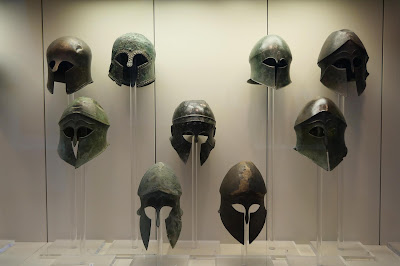The Stadium
We are still on our butterfly spotting holiday, but today we have abandoned the rest of the gang to made a side trip to Olympia, the one major site that we haven't yet seen. We got there by a high speed taxi ride over the mountains which took a while to recover from. Olympia is rather different from Delphi as it is much larger and on a flat site. The site plan indicates that the recommended route for exploration is an anti-clockwise loop, starting with the Gymnasium on the right.
Olympia is primarily about the Olympic games and so the Gymnasium, used for practicing races, javelin and discus seems a reasonable place to start. It dates from the 2nd century BC. There is not much left however, so considerable imagination is required.
Further along is the Palaestra (3rd century BC), a square building with a central courtyard surrounded by a colonnade. It was principally a training area for wrestling, boxing and jumping.
Next we passed a rather different style of building, with not a column in sight. This was once the workshop of Pheidias and later an early Christina basilica. The zone at the rear of the site has a number of buildings which have Roman origins.
A little further along was the curiously named SW Building, a complex of baths dating from the 1st-3rd century AD.
This marked the furthest point from the entrance and we now headed across the rear of the site, delighted by these unusually coloured Oleanders.
Now we came to the South portico (4th century BC) which marked the southern boundary of the site. It consisted of a interior Doric colonnade and and an outer Corinthian one. The capitals of the Corinthian columns give some idea of what it might have been like.
Beyond this, in the far corner, is the so-called Octagon, or Nero's House. It was altered in the 3rd century and occupied briefly by the Roman Emperor Nero when he attended the games
Heading now towards the front of the site, we rather ignored the Temple of Zeus on our left and passed the remains of the Echo Stoa (an covered colonade which was 100m long) which once had two tall Ionic columns topped by statues of Ptoleny and Arsinoe. One of these remains, albeit without its statue
Now we came the passageway which marks the entrance to the Stadium which was laid out in the 5th century BC. The Stadium is said to have been able to accommodate 45,000 spectators (see the photo at the head of this post).
Just along from the Stadium entrance is the Nymphaion, a monumental fountain of a kind found in Renaissance Italy, and in front of it the Altar of Hera.
The Altar has been used to light the Olympic flame ever since the Berlin Olympics in 1936.
Immediately adjacent is the Temple of Hera. Dating from the end of the 7th century BC, it is the oldest temple on the site. There were originally 6 columns across the front and rear and 16 along the sides.
Finally, we come to the circular temple called the Philippeion, restored in 2005. It was started by Philip of Macedon some time after 338 BC to mark his victory over the Greeks at Chaeronia
To complete our visit we had a quick look round the excellent Museum, whose colonaded courtyard offered a nod to Classical antiquity.
Among many interesting exhibits we especially admired this sculpture of Zeus and Ganymede. In Greel mythology Ganymede was a beautufl Trojan boy who Zeus fell in love with his and abducted him in the form of an eagle to serve as cup-bearer to the Gods.
I also found this collection of Greek helmets very striking.
Conditions: sunny and very hot.
Rating: five stars.


















No comments:
Post a Comment